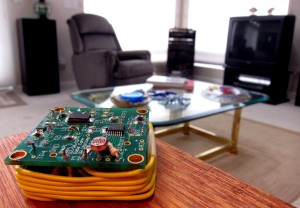 UW CSE’s Shwetak Patel and colleagues at UW and the Georgia Institute of Technology have developed a way to dramatically increase the battery life of sensors in the home, making their use far more practical.
UW CSE’s Shwetak Patel and colleagues at UW and the Georgia Institute of Technology have developed a way to dramatically increase the battery life of sensors in the home, making their use far more practical.
The approach is called SNUPI — Sensor Nodes Utilizing Powerline Infrastructure. The “trick” is to utilize the electrical wiring in the home as a gigantic antenna, picking up very low power wireless signals from sensors and carrying them to a monitoring computer.
SNUPI, which could be used in home automation or medical monitoring, will be presented this month at the Ubiquitous Computing conference in Copenhagen, Denmark. It originated when Patel and co-author Erich Stuntebeck were doctoral students at Georgia Tech and worked with thesis adviser Gregory Abowd. They discovered that home wiring is a remarkably efficient antenna at 27 megahertz. Since then, Patel’s team at the UW has built the actual sensors and refined this method. Other co-authors are UW’s Gabe Cohn, Jagdish Pandey and Brian Otis.
Read the UW News release here. Additional news coverage: TechFlash. Seattle Times. Popular Science. International Business Times. inhabitat. Slashdot. TechNewsDaily. Gizmag. R&D Magazine. Technology Review.

